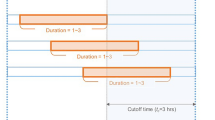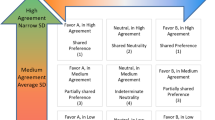Abstract
Background:
Infants admitted to the neonatal intensive care unit (NICU), and especially those born with very low birth weight (VLBW; <1,500 g), are at risk for respiratory decompensation requiring endotracheal intubation and mechanical ventilation. Intubation and mechanical ventilation are associated with increased morbidity, particularly in urgent unplanned cases.
Methods:
We tested the hypothesis that the systemic response associated with respiratory decompensation can be detected from physiological monitoring and that statistical models of bedside monitoring data can identify infants at increased risk of urgent unplanned intubation. We studied 287 VLBW infants consecutively admitted to our NICU and found 96 events in 51 patients, excluding intubations occurring within 12 h of a previous extubation.
Results:
In order of importance in a multivariable statistical model, we found that the characteristics of reduced O2 saturation, especially as heart rate was falling; increased heart rate correlation with respiratory rate; and the amount of apnea were all significant independent predictors. The predictive model, validated internally by bootstrap, had a receiver-operating characteristic area of 0.84 ± 0.04.
Conclusion:
We propose that predictive monitoring in the NICU for urgent unplanned intubation may improve outcomes by allowing clinicians to intervene noninvasively before intubation is required.
Similar content being viewed by others
Log in or create a free account to read this content
Gain free access to this article, as well as selected content from this journal and more on nature.com
or
References
Darnall RA, Ariagno RL, Kinney HC . The late preterm infant and the control of breathing, sleep, and brainstem development: a review. Clin Perinatol 2006;33:883–914; abstract x.
Barrington K, Finer N . The natural history of the appearance of apnea of prematurity. Pediatr Res 1991;29:372–5.
Apisarnthanarak A, Holzmann-Pazgal G, Hamvas A, Olsen MA, Fraser VJ . Ventilator-associated pneumonia in extremely preterm neonates in a neonatal intensive care unit: characteristics, risk factors, and outcomes. Pediatrics 2003;112:1283–9.
Fairchild KD, O’Shea TM . Heart rate characteristics: physiomarkers for detection of late-onset neonatal sepsis. Clin Perinatol 2010;37:581–98.
Griffin MP, O’Shea TM, Bissonette EA, et al. Abnormal heart rate characteristics preceding neonatal sepsis and sepsis-like illness. Pediatr Res 2003;53:920–6.
Griffin MP, Lake DE, Bissonette EA, et al. Heart rate characteristics: novel physiomarkers to predict neonatal infection and death. Pediatrics 2005;116:1070–4.
Griffin MP, O’Shea TM, Bissonette EA, et al. Abnormal heart rate characteristics are associated with neonatal mortality. Pediatr Res 2004;55:782–8.
Griffin MP, Lake DE, Moorman JR . Heart rate characteristics and laboratory tests in neonatal sepsis. Pediatrics 2005;115:937–41.
Griffin MP, Lake DE, O’Shea TM, Moorman JR . Heart rate characteristics and clinical signs in neonatal sepsis. Pediatr Res 2007;61:222–7.
Kovatchev BP, Farhy LS, Cao H, et al. Sample asymmetry analysis of heart rate characteristics with application to neonatal sepsis and systemic inflammatory response syndrome. Pediatr Res 2003;54:892–8.
Moorman JR, Delos JB, Flower AA, et al. Cardiovascular oscillations at the bedside: early diagnosis of neonatal sepsis using heart rate characteristics monitoring. Physiol Meas 2011;32:1821–32.
Moorman JR, Carlo WA, Kattwinkel J, et al. Mortality reduction by heart rate characteristic monitoring in very low birth weight neonates: a randomized trial. J Pediatr 2011;159:900–6.e1.
Clark MT, Rusin CG, Hudson JL, et al. Breath-by-breath analysis of cardiorespiratory interaction for quantifying developmental maturity in premature infants. J Appl Physiol 2012;112:859–67.
Lee H, Rusin CG, Lake DE, et al. A new algorithm for detecting central apnea in neonates. Physiol Meas 2012;33:1–17.
Godin PJ, Buchman TG . Uncoupling of biological oscillators: a complementary hypothesis concerning the pathogenesis of multiple organ dysfunction syndrome. Crit Care Med 1996;24:1107–16.
Griffin MP, Scollan DF, Moorman JR . The dynamic range of neonatal heart rate variability. J Cardiovasc Electrophysiol 1994;5:112–24.
Griffin MP, Lake DE, Bissonette EA, et al. Heart rate characteristics: novel physiomarkers to predict neonatal infection and death. Pediatrics 2005;116:1070–4.
Feng Z, McLerran D, Grizzle J . A comparison of statistical methods for clustered data analysis with Gaussian error. Stat Med 1996;15:1793–1806.
Küster H, Weiss M, Willeitner AE, et al. Interleukin-1 receptor antagonist and interleukin-6 for early diagnosis of neonatal sepsis 2 days before clinical manifestation. Lancet 1998;352:1271–7.
Ellenby MS, McNames J, Lai S, et al. Uncoupling and recoupling of autonomic regulation of the heart beat in pediatric septic shock. Shock 2001;16:274–7.
Buchman TG, Stein PK, Goldstein B . Heart rate variability in critical illness and critical care. Curr Opin Crit Care 2002;8:311–5.
Larsen PD, Galletly DC . Cardioventilatory coupling in heart rate variability: the value of standard analytical techniques. Br J Anaesth 2001;87:819–26.
Tzeng YC, Larsen PD, Galletly DC . Mechanism of cardioventilatory coupling: insights from cardiac pacing, vagotomy, and sinoaortic denervation in the anesthetized rat. Am J Physiol Heart Circ Physiol 2007;292:H1967–77.
Pan J, Tompkins WJ . A real-time QRS detection algorithm. IEEE Trans Biomed Eng 1985;32:230–6.
Li Q, Mark RG, Clifford GD . Robust heart rate estimation from multiple asynchronous noisy sources using signal quality indices and a Kalman filter. Physiol Meas 2008;29:15–32.
Tarassenko L, Clifford G, Townsend N . Detection of ectopic beats in the electrocardiogram using an auto-associative neural network. Neural Proc Lett 2001;14:15–25.
Finer NN, Higgins R, Kattwinkel J, Martin RJ . Summary proceedings from the apnea-of-prematurity group. Pediatrics 2006;117:S47–51.
White H . Maximum-likelihood estimation of mis-specified models. Econometrica 1982;50:1–25.
Wei LJ, Lin DY, Weissfeld L . Regression-analysis of multivariate incomplete failure time data by modeling marginal distributions. J Am Stat Assoc 1989;84:1065–73.
Steyerberg EW, Harrell FE Jr, Borsboom GJ, et al. Internal validation of predictive models: efficiency of some procedures for logistic regression analysis. J Clin Epidemiol 2001;54:774–81.
Author information
Authors and Affiliations
Corresponding author
Rights and permissions
About this article
Cite this article
Clark, M., Vergales, B., Paget-Brown, A. et al. Predictive monitoring for respiratory decompensation leading to urgent unplanned intubation in the neonatal intensive care unit. Pediatr Res 73, 104–110 (2013). https://doi.org/10.1038/pr.2012.155
Received:
Accepted:
Published:
Issue date:
DOI: https://doi.org/10.1038/pr.2012.155
This article is cited by
-
Predicting the need for intubation within 3 h in the neonatal intensive care unit using a multimodal deep neural network
Scientific Reports (2023)
-
Novel approaches to capturing and using continuous cardiorespiratory physiological data in hospitalized children
Pediatric Research (2023)
-
Continuous vital sign analysis for predicting and preventing neonatal diseases in the twenty-first century: big data to the forefront
Pediatric Research (2020)
-
Towards development of alert thresholds for clinical deterioration using continuous predictive analytics monitoring
Journal of Clinical Monitoring and Computing (2020)
-
Impact of predictive analytics based on continuous cardiorespiratory monitoring in a surgical and trauma intensive care unit
Journal of Clinical Monitoring and Computing (2019)



